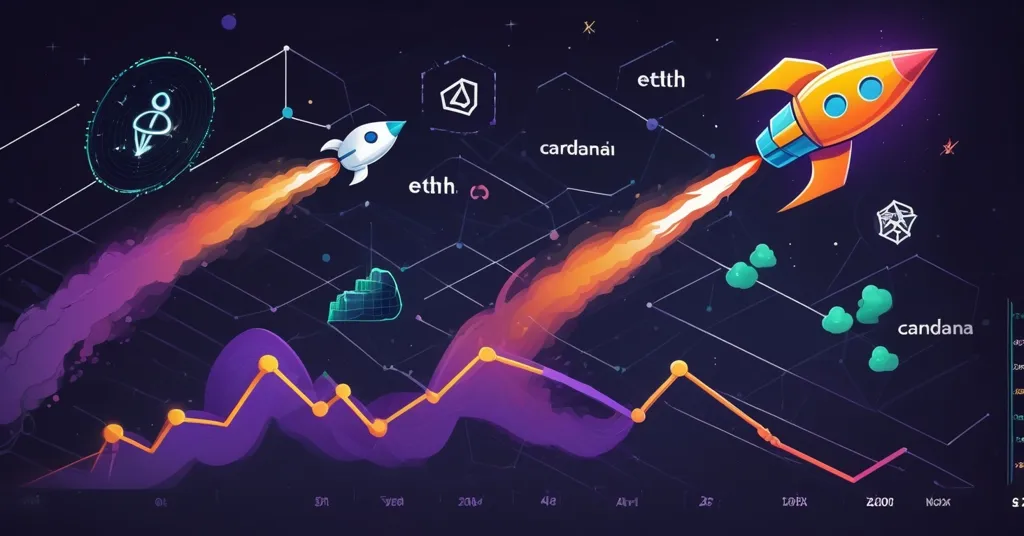Ethereum’s 2023 Surge Potential: Can ETH Repeat 2017’s 10x Growth?

Ethereum’s Next Big Leap: Can ETH Repeat Its 2017 Glory?
Ethereum’s dramatic 10x price surge in 2017, soaring from around $10 to over $1,000, has sparked curiosity about the possibility of a repeat performance. As we examine Ethereum’s current state and future prospects, we’ll delve into whether another monumental leap is feasible. From the pivotal shift to Ethereum 2.0, the booming sectors of DeFi and NFTs, to regulatory hurdles and competition from rivals like Solana and Cardano, we’ll explore the myriad factors that could send Ethereum’s value soaring—or crashing back to earth.
- Ethereum’s 2017 surge: From $10 to $1,000
- Ethereum 2.0: Transition to Proof-of-Stake
- DeFi and NFTs: Catalysts for Growth
- Regulatory Challenges: SEC’s Role
- Competition from Solana and Cardano
Back in 2017, Ethereum captivated the crypto community with its astounding 10x price increase, rocketing from a modest $10 to over $1,000. This surge was driven by the rising interest in blockchain technology and Ethereum’s unique ability to execute smart contracts. Today, Ethereum stands on the brink of a new era following the completion of Ethereum 2.0 on September 15, 2022. The transition from the energy-intensive proof-of-work (PoW) to the eco-friendly proof-of-stake (PoS) has slashed energy consumption by an impressive 99.95%. This not only makes Ethereum more sustainable but also aims to improve scalability, potentially setting the stage for another significant price surge.
The rise of decentralized finance (DeFi) and non-fungible tokens (NFTs) on Ethereum has been nothing short of spectacular. At its peak, DeFi’s total value locked (TVL)—the total amount of money invested in DeFi projects on Ethereum—reached over $200 billion, underlining the platform’s critical role in the financial revolution. Meanwhile, NFTs have burst into the mainstream, driven by high-profile sales and celebrity endorsements. Yet, this success has not come without its share of headaches. Ethereum’s high gas fees and network congestion have become notorious, pushing users to explore alternatives. The impact of DeFi and NFTs on Ethereum’s price has been a hot topic on Reddit.
The Securities and Exchange Commission (SEC) in the United States looms large over Ethereum’s future trajectory. The SEC’s stance on whether ETH should be classified as a security could have profound implications for its price. As regulatory bodies grapple with the complexities of cryptocurrencies, the presence or absence of regulatory clarity will undoubtedly shape Ethereum’s path forward. In the words of cryptocurrency analyst Mads Eberhardt, “Regulatory clarity, or lack thereof, will play a crucial role in Ethereum’s future price movements.” For the latest updates on the SEC’s regulatory stance, visit the SEC’s official website.
Yet, Ethereum is not the only contender in the blockchain arena. It faces fierce competition from platforms like Solana and Cardano. Solana boasts high transaction speeds of up to 65,000 transactions per second (TPS) and lower fees, while Cardano emphasizes research-driven solutions and sustainability. These competitors are tackling Ethereum’s shortcomings head-on, putting pressure on the platform to continuously innovate. As Eberhardt notes, “While Ethereum has been a leader in the crypto space, it faces stiff competition from other blockchains that are addressing its shortcomings.” For a detailed comparison, check out Ethereum vs. Competitors.
While Ethereum’s transition to PoS has undoubtedly made it more financially sustainable—reducing its yearly issuance to 816,000 ETH and burning transaction fees—it is not without potential pitfalls. The concentration of staking power, with liquid-staking provider Lido controlling around 32.5% of staked Ether, raises concerns about decentralization. Ethereum’s developers are working diligently to address these risks, but it’s a reminder that the road ahead is not without its challenges.
Ethereum’s ongoing efforts to tackle scalability issues are crucial. Layer 2 solutions like Optimism and Arbitrum are being developed to alleviate high gas fees and network congestion. These technologies are essential for enhancing Ethereum’s performance and user experience, potentially paving the way for a more robust ecosystem. Think of Ethereum’s scalability issues like a busy highway experiencing traffic jams; Layer 2 solutions are the equivalent of building express lanes to keep the traffic flowing smoothly.
In the broader context of the crypto market, Ethereum’s future is intricately linked to regulatory clarity. The SEC’s ongoing efforts to provide guidance on crypto assets could significantly influence investor confidence and Ethereum’s market position. Meanwhile, Ethereum’s upcoming sharding implementation promises to further boost its scalability, offering a glimpse into the platform’s potential for another significant run. For more insights into Ethereum’s regulatory challenges, visit Quora.
So, can Ethereum deliver another 10x run like 2017? It’s a tantalizing prospect, but one fraught with uncertainties. Market conditions, technological developments, and regulatory changes all play a role. While Ethereum is poised to revolutionize the crypto space, it’s essential to approach such predictions with a healthy dose of skepticism and a comprehensive understanding of the broader crypto ecosystem. For a detailed analysis, check out Ethereum Price Prediction.
Key Takeaways and Questions
- What was Ethereum’s price performance like in 2017?
Ethereum experienced a 10x price increase in 2017, rising from around $10 to over $1,000.
- What is Ethereum 2.0, and how might it impact ETH’s price?
Ethereum 2.0 is an upgrade transitioning the network from proof-of-work to proof-of-stake, potentially improving scalability and reducing energy consumption, which could lead to a significant price increase.
- How have DeFi and NFTs influenced Ethereum’s growth?
DeFi and NFTs have driven significant growth on Ethereum, with DeFi’s total value locked reaching over $200 billion at its peak and NFTs gaining massive popularity.
- What regulatory factors could affect Ethereum’s price?
Regulatory developments, particularly the SEC’s stance on whether ETH is a security, could impact Ethereum’s price.
- What challenges does Ethereum face, and how might they affect its future?
Ethereum faces challenges like high gas fees, network congestion, and competition from other blockchains like Solana and Cardano, which could affect its future growth and price.
- Is it realistic to expect another 10x run for Ethereum?
While possible, another 10x run for Ethereum is uncertain due to various factors including market conditions, technological developments, and regulatory changes.
“Ethereum’s transition to proof-of-stake with Ethereum 2.0 could be a game-changer, potentially leading to a significant price increase.”
“The growth of DeFi and NFTs on Ethereum has been phenomenal, but it also brings challenges like high gas fees and network congestion.”
“Regulatory clarity, or lack thereof, will play a crucial role in Ethereum’s future price movements.”
“While Ethereum has been a leader in the crypto space, it faces stiff competition from other blockchains that are addressing its shortcomings.”



